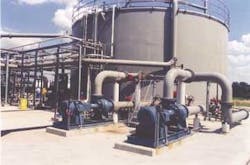Thermophilic Biosolids Reduction System Reduces Sludge Disposal Costs
By Richard Pehrson
Waste sludge from an East Coast chemical manufacturing facility's activated sludge treatment plant was costing the company over $1.5 million per year for hauling and disposal. In 1998, an onsite AFCSM (Advanced Fluidized Composting) thermophilic biosolids reduction system was installed to take the combined primary and secondary waste sludge and minimize offsite disposal requirements.
The chemical company is a manufacturer of adhesives, aircraft coolants, and assorted phenolic-based products. Wastewaters generated during the production of these specialty chemicals are treated by an on-site biological activated sludge system. The processes generate approximately 6000 gallons per day of combined primary sludge and secondary waste-activated sludge at a COD concentration of from 200,000 mg/L to over 300,000 mg/l and a solids concentration of 8% to 10%.
An economic benefits analysis for implementing a modified thermophilic sludge treatment process indicated a potential substantial cost savings could be realized by reducing sludge volumes and associated disposal costs. Based on the analysis, continuous-flow bench-scale testing was performed over a three-month period on a combined sludge grab sample. Results of the testing showed 85% total COD destruction via thermophilic biodegradation. An integral chemical treatment step showed that enhanced net solids destruction also could be achieved.
Follow-on pilot testing verified bench-scale test results, defined sludge waste characteristics, refined chemical treatment procedures, optimized cost-effective solids separation equipment, and defined solids disposal characteristics.
The AFCSM system construction was completed April 1998. The entire facility was installed on a 130' by 90' slab. The control building is 32' by 36' also housing a rotating sludge thickener. Waste sludge goes initially into a 69,000 gallon storage tank and is then fed to a 300,000 gallon (50.5' diameter by 20' water depth) covered thermophilic reactor. Reactor off gas goes to an ammonia scrubber. Jet aeration is used to meet the system's high oxygen uptake rates. There are two 50 hp jet pumps and two 200 hp centrifugal blowers. One of each is normally running with one standby. The centrifugal blower is typically run in a throttled back condition to conserve energy.
The system's current design conditions are flows from 3,000 to 4,000 gallons per day, COD levels up to 400,000 mg/l with VSS (Volatile Suspended Solids) at 80,000 mg/l, and salt at 20,000 mg/l. The thermophilic reactor runs 3% to 6% MLSS (Mixed Liquor Suspended Solids). Performance to date has yielded greater than 80% organics material destruction with significantly reduced excess sludge disposal.
"Before the AFCSM system was installed, we had over 500 trucks per year hauling wastes," said their Environmental, Health & Safety Utilities Manager, "Since AFCSM, we greatly reduced the number of trucks leaving our plant, lowering our costs by over 75%."
AFCSM, provided by PMC BioTec Co., is a proprietary combination of three unit operations: a specialized biological reactor, positive solids separation and chemical treatment. This combination enhances the biodegradation of organics while producing little if any excess waste biomass.
The biological component is a high rate thermophilic reactor. PMC has systems installed handling CODs (chemical oxygen demand) from 10,000 mg/l to over 300,000 mg/l. At these COD levels, the reactor is autothermophilic and will self heat to temperatures from 120 degree F. to 160 degrees F.
"These high temperature bacteria are superbly efficient in converting COD to water and CO2 with relatively little excess cell production," said Dr. Alan Rozich, President of PMC BioTec Co. "We use ultrafiltration for total positive solids separation, returning the majority of the solids back to the thermophilic reactor and taking a portion through chemical treatment."
The chemical treatment step enhances biodegradability, recovers nutrients and facilitates foam control.
"We don't use the chemistry to totally destroy the cells, organics or recalcitrant compounds, but to soften them up to make them more readily biodegradable," Rozich said.
"The net effect of the three units operating in concert is a high rate, high efficiency, relatively small footprint system with net sludge yields approaching zero. A specifically outstanding example of this is one of our systems, with few inerts in the influent, having treated over 7 million pounds of COD with zero sludge wasting."
In closing remarks, Dr. Rozich stated, "In addition to the direct cost savings of reduced sludge hauling and disposal, there is a significant reduction in the liability associated with off-site hauling and sludge disposal. These costs are often overlooked when evaluating the economics of on-site treatment. The liability for hauling is associated with accidents, spills and the ultimate fate of contaminants. The cost of spills can vary greatly and contingency set asides for this liability are often omitted. The liability associated with the ultimate site for sludge disposal is related to potential site cleanup costs and is also often omitted due to the difficulty of establishing a value as well as the potential enormity of this cost."
In light of the increasing public scrutiny of company accounting practices, liability set asides for waste disposal are becoming a more visible issue and the trend is likely to continue. Industries are already paying some of this price in their liability insurance premiums.
Even without the economics of the liability issue factored into project evaluation, on-site treatment of waste sludge and high strength wastewaters with high rate, low sludge yield thermophilic technology can provide an owner significant economic benefit.
For the Environmental, Health & Safety Utilities Manager, his AFCSM system met his goals. In his words, "Where most utility projects of this kind cost the company money, this project has paid for itself in two years and is now actually making the company money."
About the Author:
Richard Pehrson is a principal in Pehrson Associates assisting industry evaluate wastewater treatment options and assisting wastewater treatment companies understand and address the needs of industry. He has been actively involved in the water and wastewater industry for over 25 years, has degrees in physics, mathematics and an MBA.


